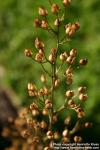Scrophularia.—Carpenter's Square.

 Preparation: Ointment of Figwort
Preparation: Ointment of Figwort
The leaves, tops, and roots of Scrophularia nodosa, Linné, var. marilandica, Gray (Scrophularia nodosa, var. Americana, Michaux).
Nat. Ord.—Scrophularineae.
COMMON NAMES: Figwort, Carpenter's square, Scrofula plant, Square stalk, Heal-all.
ILLUSTRATION: Lloyd's Drugs and Med. of N. A., Plate 37.
Botanical Source.—Scrophularia nodosa, Linné, has a perennial, whitish, tuberous, and knotty root, with a leafy, erect, quadrangular, smooth stem, 2 to 4 feet in height, with paniculate, opposite branches above. The leaves are opposite, petiolate, ovate, ovate-oblong, or the upper lanceolate, acute, sharply and unequally serrated, rounded, acutish, or broadly cordate at base, veined, of a deep-green color, and 3 to 7 inches in length. The flowers are small, 3 or 4 lines long, ovoid, dark purple, slightly drooping, on axillary and terminal, forked, angular, glandular peduncles in oblong, thyrsoid panicles. The calyx is in 5 segments, which are broadly ovate, obtuse, and slightly margined; the corolla of a dull-green color, with a livid-purple lip, and subglobose; the limb contracted, sublabiate, having a green scale or sterile filament, adnate to the upper side. Stamens didynamous; sterile anthers, broadly orbicular. Capsule ovate-oblong (L.—W.—G.). The variety marilandica, Gray, differs from the preceding chiefly in being taller (4 to 6 feet), and in having obtuse angles to the stems.
History and Description.—Figwort is a native of Europe, and found growing in different parts of the United States, in woods, hedges, damp copses, and banks, flowering from July to October. The American variety was formerly considered distinct from the European plant, and was named Scrophularia marilandica. Michaux, however, did not regard it as such, but placed it as a variety under the name Scrophularia nodosa, var. Americana, which name should have been retained. Gray, in his more recent works, gave it as the variety marilandica, under which it is now known. The plant is generally known to Eclectics as Carpenter's square; to other branches of the profession as Figwort and Scrofula plant. A variety lacking the cordate leaf-base, is more common in the southern localities of this country. It is the variety lanceolata, and the kind figured in Drugs and Med. of N. A. (see preceding page). Pursh named it Scrophularia lanceolata. The leaves and root are the medicinal parts, and yield their virtues to water or alcohol. The leaves have an offensive odor, and a bitter, unpleasant taste; the root is slightly acrid. Much of the odor and taste are lost by drying. The root is generally employed.
Chemical Composition.—J. U. Lloyd (Drugs and Med. of N. A., Vol. II, p. 112) found the root to contain a small quantity of an alkaloid, fixed oil, and a brown, amorphous resin of a peppery taste, insoluble in water and benzol, soluble in alcohol and chloroform. The herb yielded abundant mucilage, but no alkaloid. F. Koch (Archiv der Pharm., 1895) found the ether extract of the plant to contain lecithin, free cinnamic acid and butyric acid. The alcoholic extract contained caffeotannic acid, sugar (probably dextrose), and a resin, from which cinnamatic acid may be isolated. According to van de Moer (1895), the aqueous and alcoholic extracts of the herb and the seeds are poisonous. From the alcoholic extract, an amorphous, yellow powder was obtained, resembling digitalis, medicinally.
Action, Medical Uses, and Dosage.—Figwort is alterative, diuretic, and anodyne; reputed highly beneficial in hepatic diseases, scrofula, secondary syphilis, cutaneous diseases, dropsy, and as a general deobstruent to the glandular system, when used in infusion or syrup. Prof. Goss valued it highly in conditions coming under the head of struma, when the fluids and solids are depraved, and ulceration readily follows contusions. Externally, in the form of fomentation, or ointment, it is valuable in bruises, mammary inflammation, ringworm, piles, painful swelling, itch, and cutaneous eruptions of a vesicular character. The root, in decoction, and drank freely, is said, to restore the lochial discharge when suppressed, and to relieve the pains attending difficult menstruation. This plant possesses valuable and active medicinal properties. Its alterative properties are pronounced, though the remedy is very slow to produce its effects. Dose of the infusion or syrup, from 2 to 4 fluid ounces; fluid extract, 30 to 60 drops; strong tincture (℥viij to alcohol, 76 per cent, Oj), from 10 to 40 drops.
Specific Indications and Uses.—Struma; ulcerations about the eyes, ears, nose, or face; inclination to ulceration from abrasions or contusions; enlarged lymphatics, with perverted nutrition; full lips, pink and white countenance, with fullness or puffiness of the alae nasi; epiphyseal thickenings and fullness of the joints (Goss, Drugs and Med. of N. A., Vol. II, p. 115).

